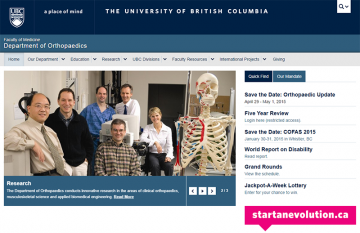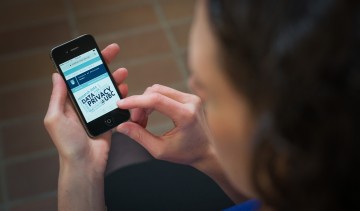When people look for information today, their resource of choice is most likely the internet. Websites have become the “front door” to an organization – which has made them one of the most important ways an organization represents itself.
This is why the Faculty of Medicine Dean’s Office Communications Group, in collaboration with MedIT, decided to take advantage of the new Common Look and Feel (CLF) offered by the Centre for Teaching, Learning and Technology (CTLT). The CLF is a web design framework that provides a common look, feel and functionality to all UBC websites. By adopting a form of the CLF specifically stylized for the Faculty of Medicine across its sites, the Faculty could visually identify itself in a consistent way: presenting itself as a cohesive top-tier organization to external audiences.

The Department of Orthopaedics adopted the CLF for the first time, and now benefits from CTLT hosting and WordPress support.
Other benefits of the CLF include mobile compatibility, ensuring the growing number of smartphone and tablet visitors have an optimal viewing experience, and free hosting from CTLT, removing site maintenance and domain hosting costs.
It was a big move – 112 sites adopted the new CLF. Fourteen sites moved to the .med domain, and eleven sites moved to free CTLT hosting services. Twenty-eight sites were retired after analysis with departments and units determined that they were no longer required, obsolete, or belonged under the umbrella of another site.
More than migration
The project went beyond giving a new face to old content. While a number of migrations were essentially “copy-and-paste” processes, site audits revealed that many sites required assistance to meet web best-practices, or had special considerations around essential functionality.
As a result, the project team offered website content reorganization, consultation and design support services – allowing sites to be updated without incurring third-party fees. Based on typical industry consulting fees, this resulted in an average cost savings of $2,500 per site, or $280,000 for all 112 sites.

The new CLF is mobile compatible.
However, the services offered by the project team had benefits beyond cost savings. By pursuing one-on-one engagement with site administrators, the project team was able to prompt them to carefully consider the presentation of their sites, resulting in overall higher quality sites across the Faculty of Medicine. They also raised awareness of support options and related services, ensuring that site administrators felt empowered to better manage their sites.
In addition to existing support options, the project team initiated WordPress and Writing for the Web workshops to provide current and future site administrators with the necessary tools and skills needed to effectively manage their sites. Since May 2013, 114 people have attended the training.
The ability to reflect
For the first time, Google Analytics was set up for all migrated sites. This will allow site administrators to observe the way visitors interact with their sites, informing future content and design decisions. In addition to individual Google Analytics dashboards for each site, the team also created a Faculty-wide dashboard. This provides the Dean’s Office Communications Group with a bird’s-eye view of how people interact with the Faculty of Medicine online, providing insight into opportunities for alignment.
As the way people interact with technology changes, so do web design best practices. While the team will have to migrate the sites to a different CLF again in the future, they now have improved data reporting capabilities and established relationships in order to ensure the move will be even smoother in the future.
Related: